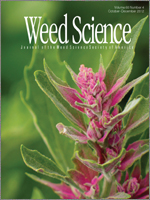In previous research conducted on nonweed species, the efficacy of glyphosate was shown to be greater in unsterile soils compared to sterile soils and soil microorganisms were found to play an important role in glyphosate efficacy. Conducting greenhouse studies in microbe-free soil may therefore produce unreliable data, leading to erroneous conclusions. The objective of this study was to determine the effect of soil microorganisms on the response of glyphosate-resistant and -susceptible biotypes of three problematic weeds of the midwestern United States: giant ragweed, horseweed, and common lambsquarters. A greenhouse dose–response study was conducted on each of the three weed species grown in sterile and unsterile field soil, and the dry weight response of roots and shoots was measured. The three weed species responded differently to glyphosate when grown in the sterile and unsterile soil; that is, in the presence and absence of soil microbes. Soil microbes influenced the response of the susceptible and resistant giant ragweed biotypes and the susceptible common lambsquarters, but not the tolerant common lambsquarters or either horseweed biotype. The different responses of the three species to glyphosate in the presence and absence of soil microbes demonstrates that rhizosphere interactions are fundamental to the mode of action of glyphosate. These findings suggest that the range of tolerance to glyphosate observed in weeds and the evolution of resistance in weed biotypes may also be influenced by rhizosphere interactions. The soil media used in dose–response screenings to identify susceptible and resistant weed biotypes is very important. Unsterile field soil should be incorporated into growth media when conducting dose–response screenings to avoid false-positive results. In addition, researchers performing glyphosate dose–response assays should be aware of these findings.
Nomenclature: Glyphosate; common lambsquarters, Chenopodium album L. CHEAL; giant ragweed, Ambrosia trifida L. AMBTR; horseweed, Conyza canadensis (L.) Cronq. ERICA.





